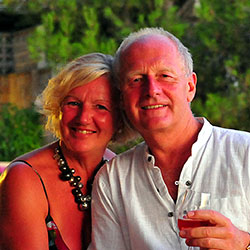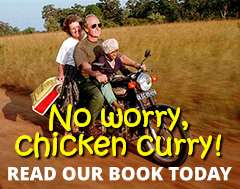Found throughout Malaysia and the Far East, Peranakans are native-born people of mixed local and foreign ancestry – none more so than in Penang, where the Straits-Chinese epitomise the eclectic mix of nationalities, ethnicities, religions and architecture to be found in this melting pot of East and West. We don’t think you’ll find a more kaleidoscopic reflection of culture anywhere.
Peranakan means ‘child’ or descendant’ and mixes of Dutch, Indian and Thai also exist in smaller numbers elsewhere but Penang seems to bring it all together as a result of British interest in the island, when Captain Francis Light, an English trader-adventurer of the British East India Company, set foot on it in July 1786.
Although much had gone before it was the establishment of Penang as an entrepot for the East India Company that put it on the map and led to it becoming the Malaysian powerhouse for trade; attracting ethnic groups from all over the Orient.

The Penang waterfront gives an immediate insight into the cultural diversity of the island
Our interest was primarily in travel rather than trade when we set foot in George Town, the capital. It’s probably here that within a few square miles you can immerse yourself in the ambiance of practically every culture under the sun, yet still feel that the island retains its own character.
Penang, sometimes referred to as the ‘Pearl of the Orient’, is known for its soft sandy beaches, such as Tanjung Bungah and is also regarded as the food capital of Malaysia. The view from the summit of Flagstaff Hill is noteworthy; as are the vipers of the Snake Temple but with limited time we decide to concentrate on George Town itself.

One of the ubiquitous cycle tri-shaws poodles past Fort Cornwallis
It’s quite easy to walk around the compact, largely flat city centre to cover all of the areas of interest, although you can enjoy the tour on a cycle tri-shaw peddled lethargically by a local.
We start our tour at Fort Cornwallis, named after Charles Cornwallis the former Governor General of India. The unusual star-shaped fortress of low stone walls, built in 1810, is the largest standing fort in Malaysia but more notable for its location and shape than for anything of significance within its walls. It’s nevertheless a landmark on the eastern coastal tip of George Town and a gathering spot for the traditional tri-shaws.
After passing the regal, colonial style, city hall we move inland and immerse ourselves in the varied and diverse ethnic architecture and cultural history of the area.
You can’t walk far without coming across significant buildings dedicated to most religious denominations, including St. George’s church, the Kapitan Keling Mosque and several Hindu shrines and Buddhist temples.

Worshippers at the Kuan Yin Teng or Kong Hock Keong (Goddess of Mercy) Temple
We stop at the Kuan Yin Teng or Kong Hock Keong (Goddess of Mercy Temple), which was built on feng shui principles in the early 1700’s and has since gone through several iterations in terms of the deity it represents and the use of the building. Originally it controlled Chinese secular and religious matters until the Penang riots of 1867 between different dialect factions, when the Chinese Town Hall took over secular matters. The Taoist temple then focussed on worship of Guanyin and its fascinating sweeping roof shapes topped with ornate dragon carvings.leave you in no doubt of its significance in the community.
Worshippers buy large incense sticks to light with them held high above their heads, enter the shrine, whilst outside, large smouldering torches add a mystical cloud of smoke around children who congregate by the cages of brightly coloured birds. Parents purchase the birds to set them free with prayers for good luck and the whole colourful spectacle keeps us intrigued for sometime.

Memorial plaques to ancestors and extended family in the Khoo Khongsi Chinese clanhouse
Perhaps of more interest to us are the Chinese ‘Clan Houses’, dedicated to the lineage of individual families. These incredibly ornate edifices are richly decorated with works of art as well as being distinctive in their architecture. One such place is the Khoo Khongsi Chinese clanhouse for those with the surname Khoo.
This clanhouse, also known as Dragon Mountain Hall, acts as a representation of the family’s social and spiritual commitments between the family, its relations, ancestors and the outside community. The artworks of sculpted stone and paintings are wonderfully intricate, as are the pillars that support the sweeping, curved, tiled roof.

Entrance to Khoo Khongsi Chinese clanhouse between traditional ‘shophouses’
Older parts of town still retain the traditional ‘shophouses’ or terraces of colourful buildings that consist of narrow fronted shops with accommodation above that might extend many metres deep, sometimes to the next street. They usually feature ‘open to air’ spaces such as courtyards or narrow strips of ventilation between them to allow air circulation; a pitched roof of clay tiles and ‘five-foot-ways’ of covered verandas along the road to protect pedestrians from the elements. They’re an attractive feature of Penang and well worth the detour to view them – such as around Lebuh Armenian – many of the alleyways revealing hidden gems in terms of Chinese design.
Delve deeper into the backstreets and every corner brings fresh views of little shops selling colourful religious torches, foodstuffs of all cultures and hardware of indeterminate use; al housed within quaint pastel coloured buildings with fading shutters and well-worn doorways.
Whilst most communities gather together and are identifiable by their wares or architecture, it’s a surprise to find a sign announcing ‘Little India’, a group of streets dedicated to spices, curry and Hinduism.
Wherever you go in George Town you’ll be intrigued, inspired or simply impressed by the breadth and range of sights, colour, wildlife, sounds and smells – all encapsulated within a relatively small area that will give you a whistle-stop tour of the Orient within one location.
Whether as a stand-alone destination or as a stopover, Penang will give you a flavour of Asia that you’ll find hard to match anywhere else on earth. Our brief visit barely scratched the surface of the deep cultural identities within the town that span centuries of beliefs, practices, liaisons, feuds and alliances that have defined the communities within it – a tempting invitation to return and learn so much more.

A word to the unwise
Its perhaps this turbulent amalgam of ethnicity that has led to Penang’s less than benign stance on controlling the excesses of its population, as we are reminded by a sign at our port of entry that the death penalty awaits any would-be importer of drugs into this melting pot of cultures.
This, however, need hardly bother the innocent traveller who has nothing more in mind than sunning themself on the beaches and shopping in the markets of this wonderful destination.

Fast fishing launches feed the hungry restaurants and markets for tourists and locals alike
Fancy a similar trip? If you’d like to plan your own
personal itinerary then simply phone 01202 030443
or click on the TLC World logo to the right





















































